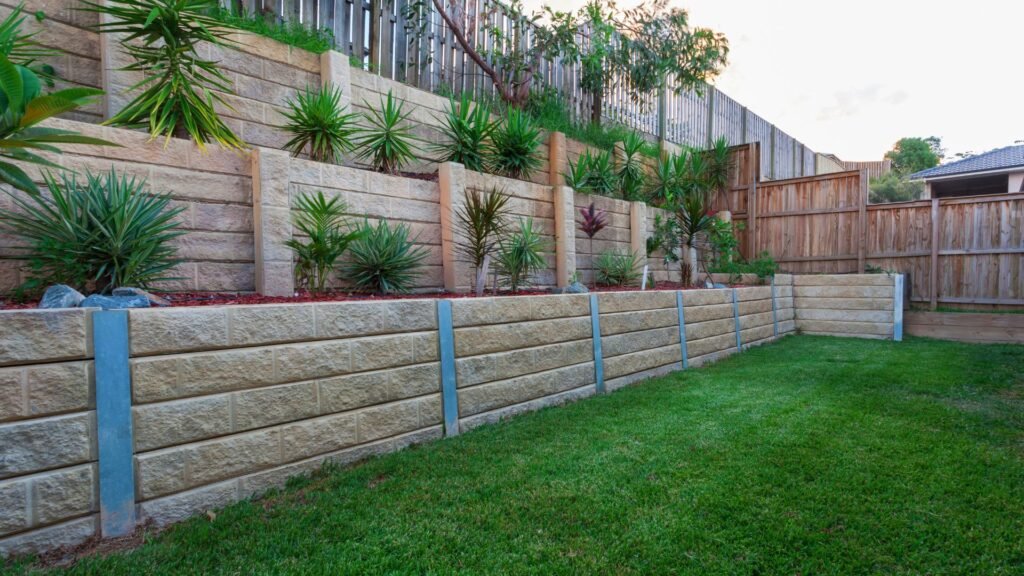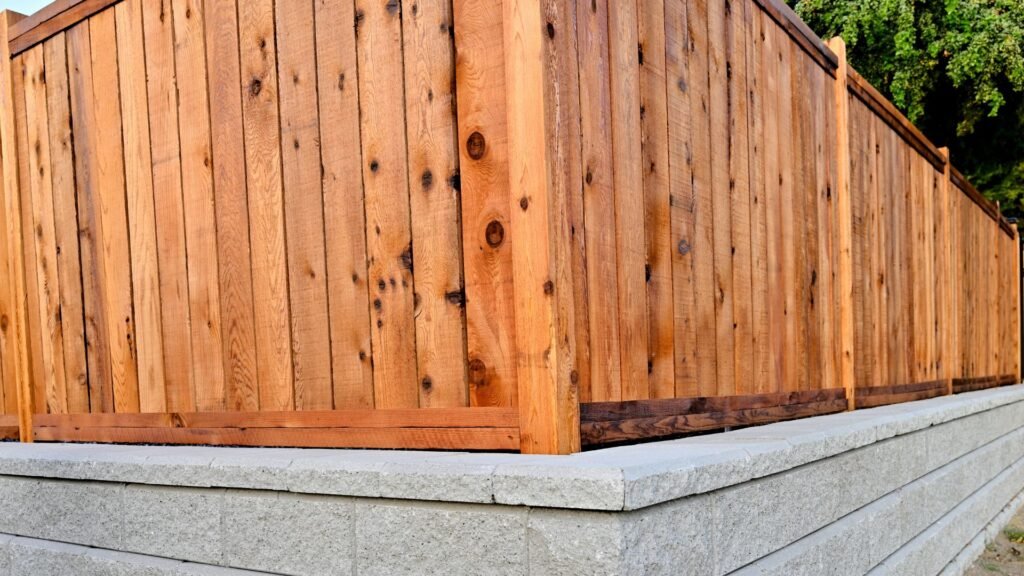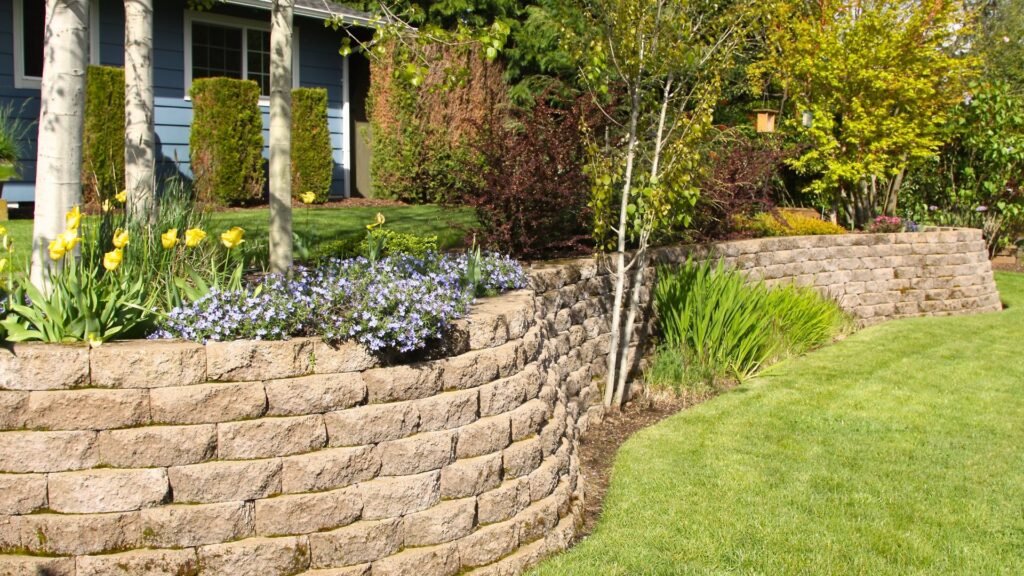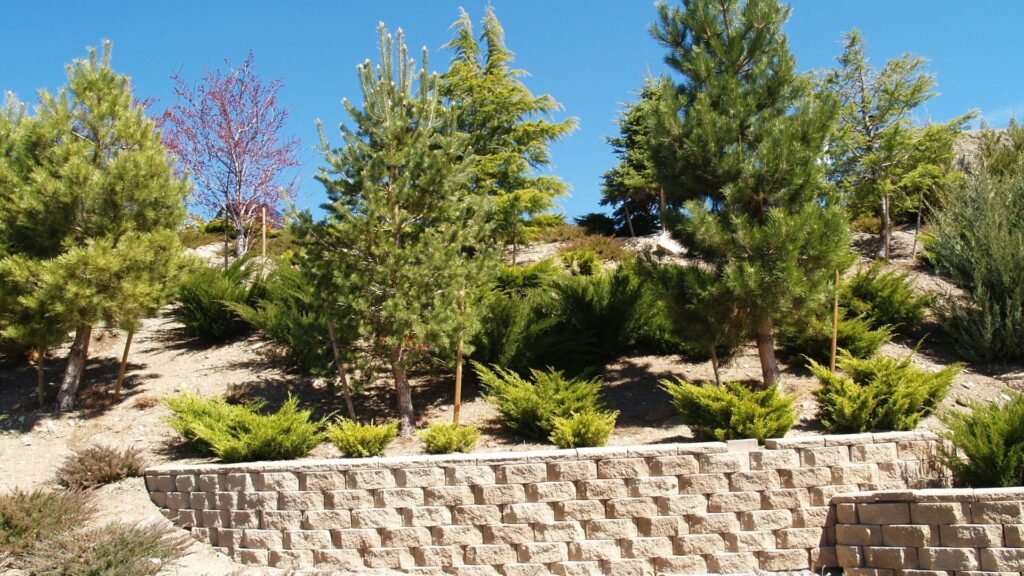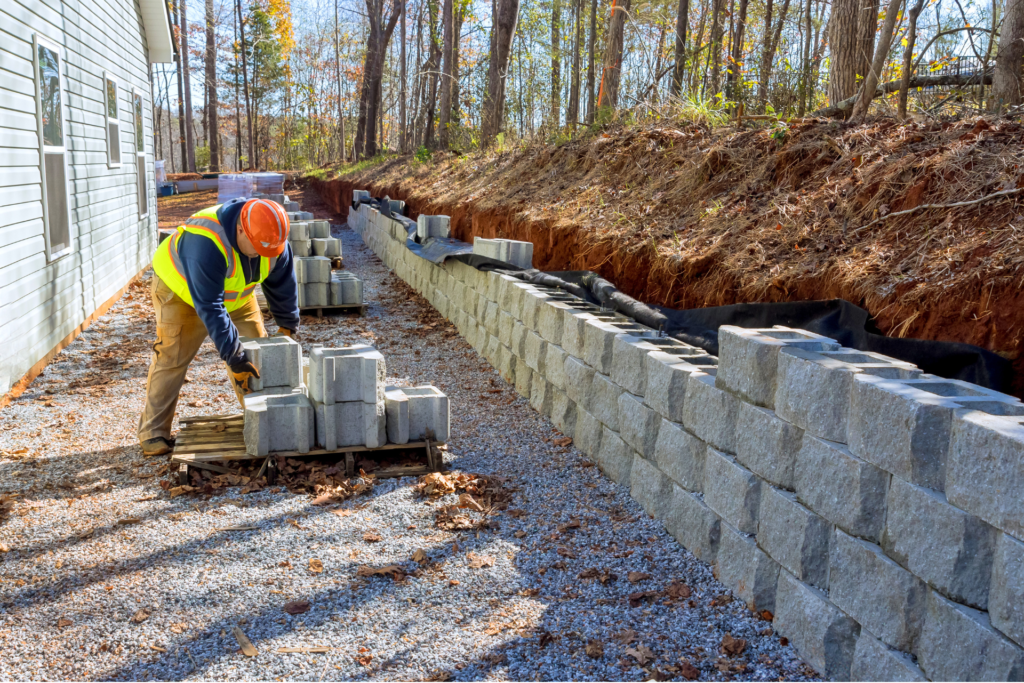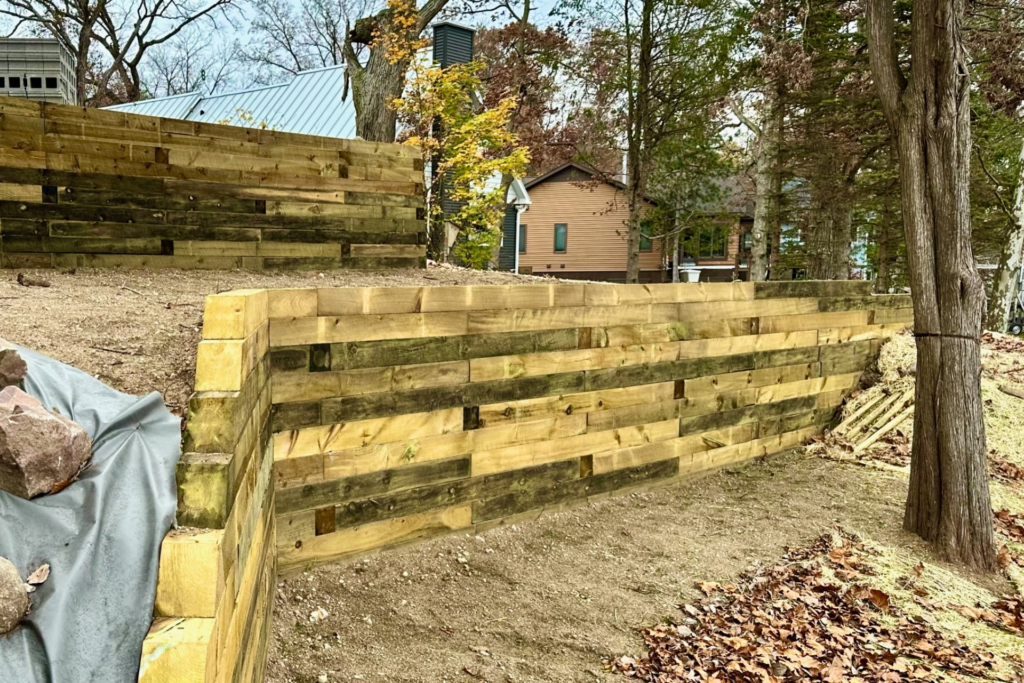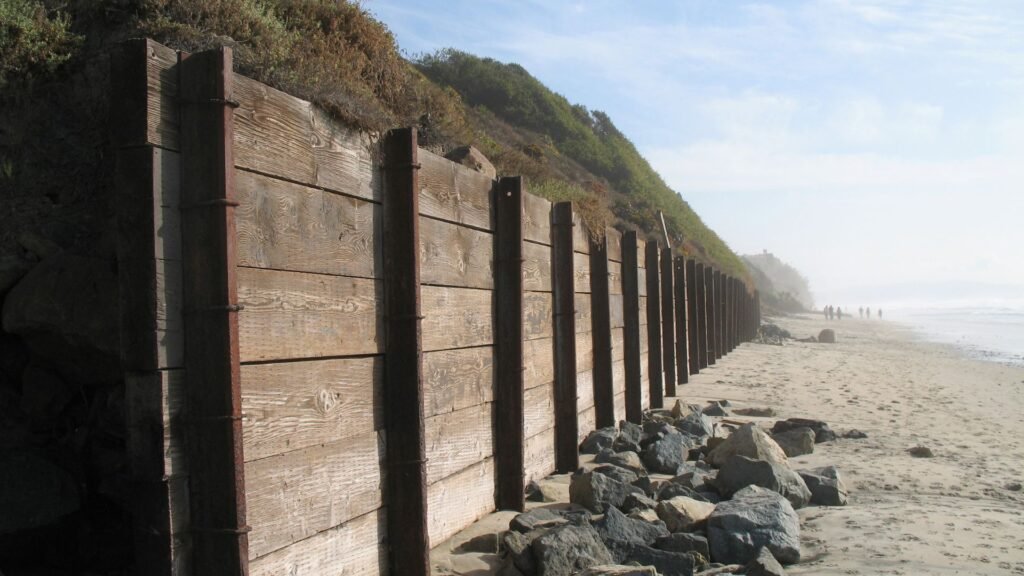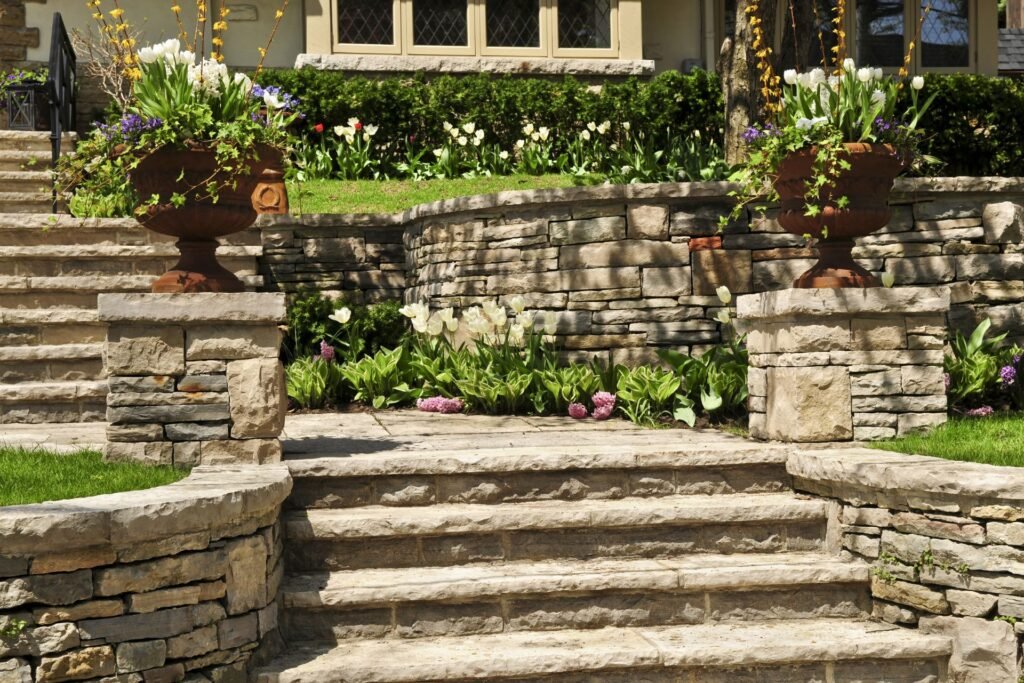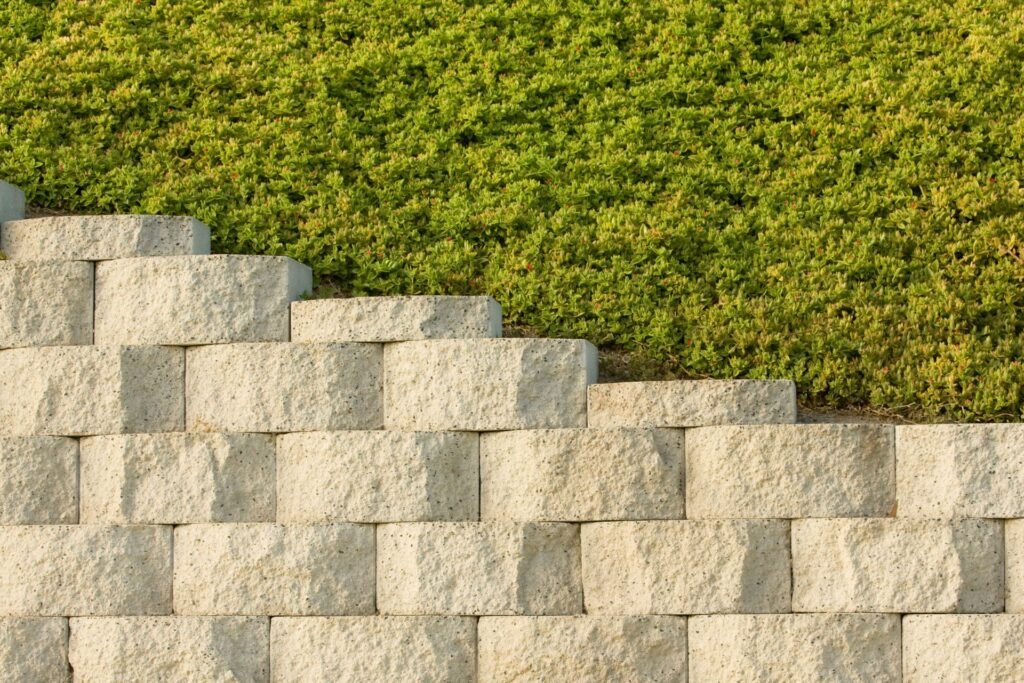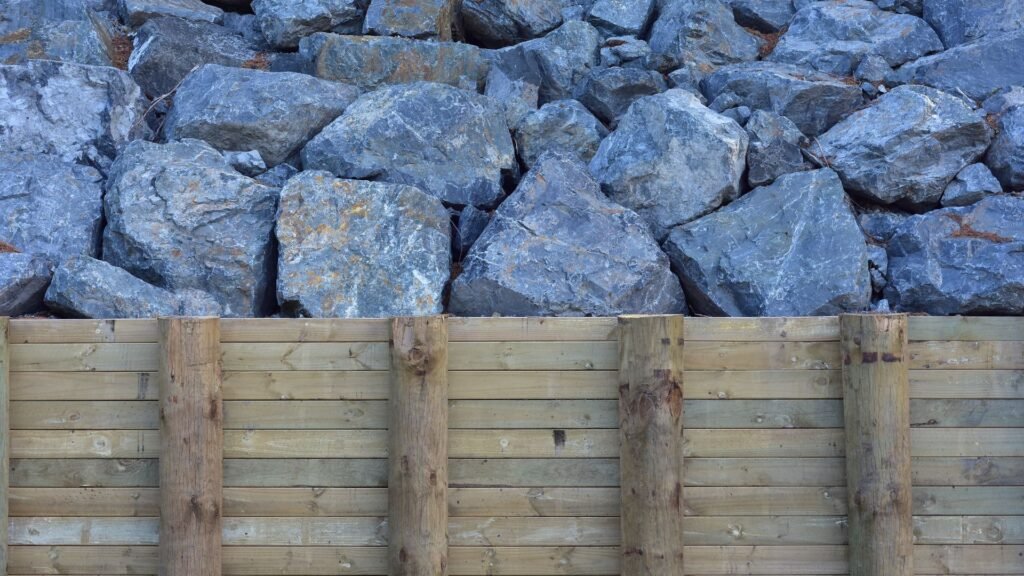Welcome to the ultimate guide on retaining walls in New Zealand! Whether you’re a homeowner dealing with a sloping backyard or someone looking to enhance your outdoor space, retaining walls can be an incredibly useful solution. Not only do they help manage soil and prevent erosion, but they also add structure and beauty to your garden, patio, or driveway. With New Zealand’s varied terrain, retaining walls have become a popular landscaping feature for both functionality and aesthetics. In this guide, we’ll explore everything you need to know about retaining walls in NZ—from the different types and materials to the benefits and considerations for installation. Whether you’re tackling a DIY project or considering professional help, you’ll find all the insights you need right here!
A retaining wall in New Zealand is a structure designed to hold back soil and prevent erosion, commonly used in sloped areas. Popular materials for retaining walls in NZ include timber, concrete, stone, and gabion baskets. They not only help create level spaces in hilly landscapes but also enhance the aesthetic appeal of gardens and outdoor areas. Retaining walls improve land usability, prevent soil movement, and can increase property value when properly designed and installed.
Table of Contents
What Are Retaining Walls And Why Are They Important In NZ?
Retaining walls are a critical feature in both urban and rural landscapes, especially in a country like New Zealand, where the natural terrain presents unique challenges. In essence, a retaining wall is a structure designed to hold back or support soil, preventing it from shifting or eroding. This allows for the creation of level areas in places where the land naturally slopes or where erosion may be an issue. By stabilizing the soil, these walls help homeowners and land developers maximize usable space while protecting property from the natural forces that shape the landscape.
Why Are Retaining Walls Crucial in New Zealand?
New Zealand is known for its varied terrain, which includes rolling hills, steep slopes, and rugged coastlines. While these geographical features make for stunning landscapes, they also contribute to common problems like soil erosion, land instability, and the challenge of managing stormwater runoff. As a result, retaining walls have become an essential feature for many properties, offering both functional and aesthetic benefits.
One of the most common issues homeowners face in New Zealand is soil erosion, particularly in areas with heavy rainfall or where the soil has been disturbed by construction. For instance, during a heavy downpour, rainwater can quickly erode loose soil, causing landslides or compromising the stability of slopes. This can lead to significant damage to homes, gardens, and driveways. Retaining walls act as a barrier, holding the soil in place and preventing it from washing away during rainstorms. By controlling the movement of soil and water, these structures help mitigate the effects of erosion, protect property, and contribute to overall landscape stability.
Types of Landscapes That Benefit from Retaining Walls
Retaining walls are not just for large-scale projects; they can be incredibly beneficial in everyday residential and agricultural settings across New Zealand. Here are a few examples of landscapes where retaining walls can make a big difference:
- Gardens: In sloped gardens, a retaining wall can create terraced sections, turning a steep incline into multiple flat areas for planting. This not only makes gardening more practical but also enhances the aesthetic appeal of the space by introducing visual layers.
- Driveways: In properties where the land slopes towards the street, a retaining wall can provide essential support to prevent soil from spilling onto the driveway or road, maintaining a clean and safe entrance.
- Patios: For those looking to create outdoor living spaces, retaining walls can level out the ground, making it possible to build a patio or deck in areas that would otherwise be too uneven for use.
- Small Farm Plots: In rural areas, retaining walls can be especially useful for creating flat planting zones on hillsides, allowing for more efficient use of land for crops and livestock.
Retaining walls in New Zealand serve as both a practical solution to environmental challenges and an opportunity to enhance the usability and beauty of outdoor spaces. By addressing issues like soil erosion, land instability, and water management, these structures play a vital role in maintaining the health and safety of the landscape. Whether in urban settings or on rural farms, retaining walls are an essential tool for making the most of New Zealand’s stunning but challenging topography.
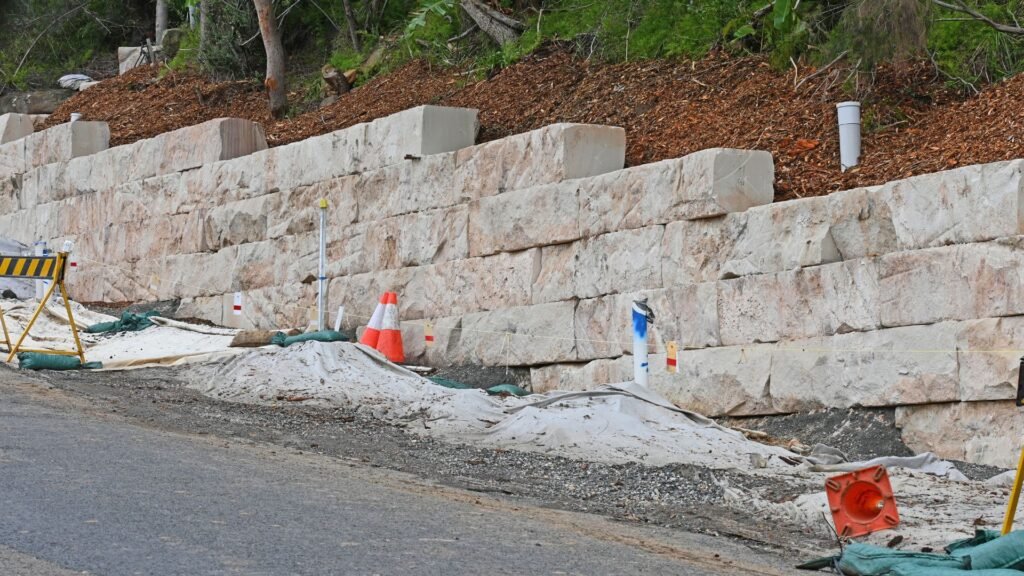
Common Types Of Retaining Walls In New Zealand
Retaining walls serve as an essential part of landscaping, helping to prevent soil erosion, manage sloped terrain, and create visually appealing outdoor spaces. In New Zealand, the diverse terrain and climate conditions require various types of retaining walls to suit specific needs. Whether for practical or aesthetic purposes, choosing the right type of retaining wall can make a significant difference in both durability and appearance. Below, we explore the most common types of retaining walls used in New Zealand, along with their benefits, drawbacks, and ideal use cases.
1. Timber Retaining Walls
Overview
Timber retaining walls are a popular choice among homeowners and DIY enthusiasts due to their cost-effectiveness and ease of installation. Made from treated wood, these walls can be a simple yet effective solution for smaller landscaping projects.
Pros:
- Affordable: Timber is one of the most budget-friendly options for building retaining walls, making it a great choice for those looking to minimize costs.
- Blends with Natural Landscapes: Timber has a warm, organic appearance that integrates seamlessly with garden environments, adding a rustic charm to outdoor spaces.
Cons:
- Limited Lifespan: Despite being treated, timber is still susceptible to rotting and decay over time, particularly in moist environments, which can limit its longevity compared to other materials.
- Maintenance Requirements: Timber retaining walls often require more upkeep, including treatments to prevent decay, insect infestation, or warping.
Use Case
Timber retaining walls are best suited for small garden projects or areas where the wall doesn’t need to withstand heavy loads or water pressure. They are an excellent choice for low-slope terrains and residential landscaping where aesthetics are a priority.
2. Concrete Retaining Walls
Overview
Concrete retaining walls are known for their strength and durability, making them a reliable choice for both residential and commercial applications. They can be built using poured concrete or precast concrete blocks, offering flexibility in design and construction.
Pros:
- Long-lasting and Strong: Concrete is highly durable and can last for decades with minimal maintenance, making it ideal for areas that require long-term solutions.
- Low Maintenance: Once installed, concrete retaining walls require very little upkeep, providing a worry-free option for property owners.
Cons:
- Higher Cost: Concrete walls tend to be more expensive to build, primarily due to the cost of materials and the labor required for installation.
- Labor-intensive Installation: Installing concrete retaining walls often requires specialized equipment and skilled labor, which can add to the overall project timeline and budget.
Use Case
Concrete retaining walls are perfect for large-scale projects or areas that require significant strength and stability, such as sloped driveways, commercial properties, or areas that experience heavy water flow. Their robust structure can easily handle greater pressure compared to other types of walls.
3. Stone Retaining Walls
Overview
Stone retaining walls offer a timeless, natural aesthetic that blends beautifully with the surrounding landscape. These walls are often used in more scenic, rural settings and can add significant value to a property due to their upscale appearance.
Pros:
- Naturally Beautiful: Stone walls have a classic, natural look that complements New Zealand’s outdoor environments. The unique texture and color variations of natural stone create a visually striking feature in any garden or landscape.
- Long Lifespan: Stone retaining walls, when properly installed, can last for generations with minimal wear and tear.
Cons:
- Expensive: Natural stone is one of the most expensive materials for retaining walls, both in terms of the cost of the stone itself and the professional labor needed to construct the wall.
- Heavy: The sheer weight of stone makes it difficult to install, often requiring skilled contractors and heavy machinery.
Use Case
Stone retaining walls are ideal for scenic gardens and upscale landscaping projects where aesthetics are a top priority. These walls are often used in heritage properties, vineyards, or luxury homes that require a natural, elegant finish.
4. Gabion Retaining Walls
Overview
Gabion retaining walls are a modern, eco-friendly solution that uses wire baskets filled with stones or rocks. These walls offer a unique aesthetic while being practical and functional, particularly in areas with high water flow.
Pros:
- Sustainable and Environmentally Friendly: Gabions can be filled with recycled materials such as local rocks or even construction debris, making them a sustainable choice.
- Good Drainage: The porous nature of gabion walls allows water to pass through, preventing pressure buildup and reducing the risk of erosion behind the wall.
- Unique Aesthetic: The raw, industrial look of gabion walls can create a striking contrast in modern landscapes, especially when paired with contemporary architecture.
Cons:
- Limited in Height: Gabion walls generally have height limitations due to the structural properties of the wire baskets and loose materials.
- Rust Potential: If the wire mesh is not treated or coated properly, it can rust over time, especially in coastal areas with high salt exposure.
Use Case
Gabion retaining walls are particularly well-suited for coastal properties or gardens that experience heavy water flow. Their excellent drainage capabilities make them a practical choice for areas prone to excess moisture, while their modern design adds a unique touch to the landscape.
Choosing the right type of retaining wall in New Zealand depends on several factors, including budget, project size, and aesthetic preferences. Timber walls are great for small DIY projects, while concrete walls provide unmatched strength for larger areas. Stone walls add a timeless elegance, and gabion walls offer a modern, eco-friendly solution with excellent drainage capabilities. By selecting the appropriate material, you can ensure your retaining wall not only serves its functional purpose but also enhances the overall look of your outdoor space.

Benefits Of Retaining Walls In New Zealand
Retaining walls are a common and essential feature in many New Zealand landscapes. They offer several benefits, not just for structural integrity but also for enhancing the functionality and aesthetics of outdoor spaces. In this section, we’ll explore how retaining walls serve multiple purposes, from preventing soil erosion to increasing property value.
1. Erosion Control
One of the most important roles of a retaining wall is to combat soil erosion, particularly in areas that experience frequent rainfall or are located near bodies of water. In New Zealand, where the climate can vary greatly from region to region, controlling erosion is critical for maintaining stable landscapes. Heavy rain can cause soil to wash away, especially on sloped terrains, leading to land degradation, flooding, and even property damage. A properly constructed retaining wall acts as a barrier, holding back the earth and stabilizing the soil. This is especially important in areas prone to landslides or near coastal regions, where the risk of erosion is higher due to fluctuating water levels and wind erosion. By building retaining walls, homeowners and property managers can protect their land from the adverse effects of erosion while also contributing to the environmental stability of the area.
2. Maximizing Usable Space
New Zealand’s unique topography, with its rolling hills and sloped terrains, can make it difficult to fully utilize outdoor spaces. Retaining walls offer a practical solution by transforming uneven or sloped land into level, usable spaces. This allows homeowners to make better use of their property, turning previously unusable areas into flat terraces ideal for patios, gardens, or additional parking space. For example, in urban areas like Wellington, where steep hillsides are common, retaining walls can create valuable outdoor living areas, enhancing both the functionality and enjoyment of the property. Additionally, in agricultural or rural settings, retaining walls help maximize arable land, providing a solution for farming on challenging terrains. By leveling out these sloped sections, property owners can expand their usable space without compromising the natural beauty of the land.
3. Aesthetic Appeal
Beyond their functional benefits, retaining walls can also significantly enhance the visual appeal of a property. When thoughtfully designed, they serve as an attractive architectural feature that complements the surrounding landscape. Retaining walls can be built from a wide range of materials, including natural stone, timber, and concrete, each offering a different aesthetic to suit the style of the home and environment. In residential settings, retaining walls can create striking garden beds, define outdoor spaces, or highlight specific landscape features. For commercial properties or public parks, retaining walls can add structure and formality to the environment, creating an organized and appealing layout. Whether the goal is a rustic, natural look or a sleek, modern design, retaining walls offer versatility in style, making them a valuable addition to any outdoor space in New Zealand.
4. Property Value Increase
A well-designed and properly constructed retaining wall can significantly increase the value of a property. In New Zealand’s competitive real estate market, buyers are often looking for properties that offer not just aesthetic appeal but also practical benefits. Retaining walls can provide both. They not only improve the functionality of outdoor spaces but also enhance curb appeal, making a property more attractive to potential buyers. Whether it’s creating additional garden space, improving the safety and stability of the land, or simply adding an eye-catching design feature, retaining walls can be a wise investment. Prospective buyers are likely to see the added value in properties with well-executed landscaping, especially those that solve common problems like erosion or steep slopes. As a result, properties with retaining walls often stand out in the market, leading to higher resale values and quicker sales.
Retaining walls in New Zealand offer a range of benefits, from protecting against soil erosion to improving the overall usability and visual appeal of a property. For homeowners and property developers alike, these structures not only enhance the functionality of the landscape but also provide a solid return on investment by increasing property value. When built with quality materials and thoughtful design, retaining walls are a durable, attractive, and practical solution for many of the challenges posed by New Zealand’s diverse terrain.
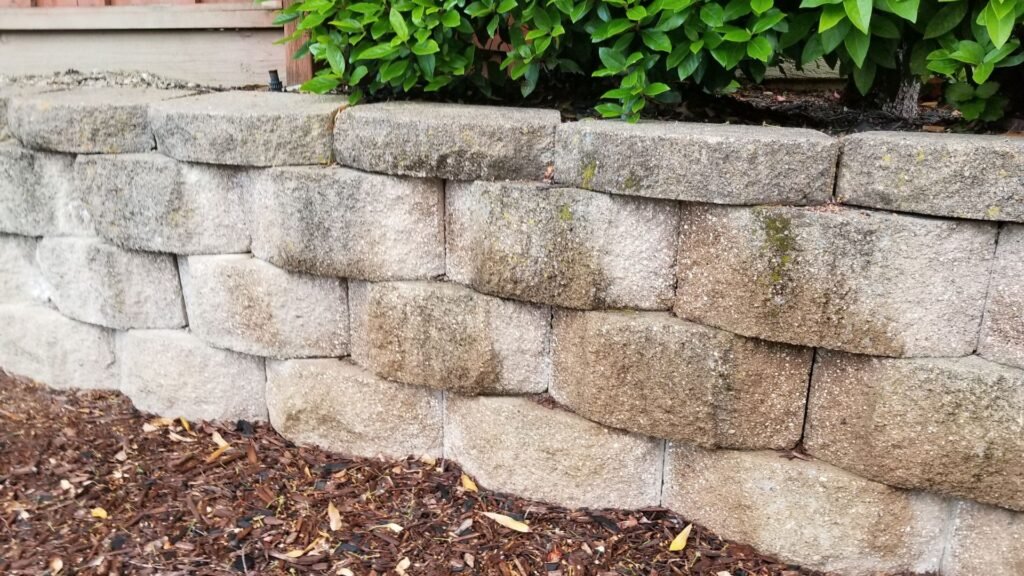
How To Choose The Right Retaining Wall For Your NZ Home
When it comes to enhancing your outdoor space in New Zealand, choosing the right retaining wall is crucial for both functionality and aesthetics. Whether you’re looking to prevent soil erosion, expand usable garden space, or add a decorative touch, here’s a step-by-step guide to making the best decision for your property.
1. Purpose: Defining Your Retaining Wall’s Role
The first step in selecting the ideal retaining wall is understanding its primary purpose. Ask yourself: What do I need this wall to achieve?
- Erosion Control: If your property is on a slope, a retaining wall can prevent soil erosion by stabilizing the land. This is especially important in areas that receive heavy rainfall, common in parts of New Zealand.
- Expanding Usable Space: Sloped properties often limit usable outdoor space. By building a retaining wall, you can create level areas for gardens, patios, or play zones, transforming previously unusable areas.
- Aesthetic Enhancement: Sometimes, retaining walls serve a more decorative function. Whether it’s to add texture to your landscaping or complement the architectural style of your home, the design and material choices will reflect this.
By determining the primary goal, you can move forward with a clear vision, which will guide other decisions regarding materials, size, and style.
2. Budget: The Financial Factor
Your budget is a significant factor in the type of retaining wall you can install. Different materials come at varying price points, and understanding these options will help you make informed decisions.
- Timber Retaining Walls: These are often the most affordable option, making them a popular choice for homeowners on a budget. Timber is relatively easy to work with and blends naturally into many landscapes. However, while cost-effective, timber may not last as long as stone or concrete, especially in areas with high moisture or termites.
- Stone or Brick Retaining Walls: On the higher end of the price spectrum, stone and brick offer a timeless, premium look. They are durable and require less maintenance compared to timber. These materials can withstand NZ’s varying weather conditions, making them a long-term investment for your property.
- Concrete Retaining Walls: Concrete is a versatile option that sits somewhere between timber and stone in terms of cost. It’s incredibly durable and can be customized with different finishes and colors, allowing for both functional and aesthetic flexibility.
When deciding on materials, consider not only the initial cost but also long-term maintenance expenses. Sometimes, spending more upfront can save you money over time.
3. Soil and Drainage Considerations: Ensuring Longevity
In New Zealand, the type of soil on your property plays a critical role in the stability and longevity of your retaining wall. Different soil types, such as clay, sand, or loam, have varying drainage and pressure characteristics that will impact how your wall performs.
- Soil Type: For example, clay soil tends to retain water, which can increase the pressure behind the wall, leading to cracks or structural failure over time. On the other hand, sandy soil drains better but may require extra reinforcement to hold its structure.
- Drainage: Without proper drainage, water can build up behind your retaining wall, leading to increased pressure and potential failure. Installing weep holes, drainage pipes, or gravel behind the wall ensures water flows through rather than building up, preserving the wall’s integrity.
To prevent issues, it’s important to consult a professional to assess your soil type and recommend the best design and materials for your specific conditions.
4. Council Regulations and Permits: Staying Compliant
In New Zealand, building regulations for retaining walls vary depending on the size and location of the project. If you plan to build a wall over 1.5 meters in height, you may need a permit from your local council.
- Why Permits Are Required: Larger retaining walls pose a greater risk if they fail, which is why permits and inspections are often necessary to ensure they meet safety standards. This includes checking structural integrity, drainage, and proper reinforcement.
- Check with Your Local Council: Before starting your project, it’s essential to research your local council’s specific requirements. In some cases, even smaller walls may need approval if they are close to property boundaries, public spaces, or involve significant changes to the land. Failing to obtain the required permits could lead to fines or the need to dismantle the wall.
In summary, choosing the right retaining wall for your NZ home involves careful planning around the purpose, budget, soil type, drainage, and local regulations. By taking the time to understand each of these factors, you can ensure that your retaining wall not only looks great but also stands the test of time, enhancing your property’s value and functionality.
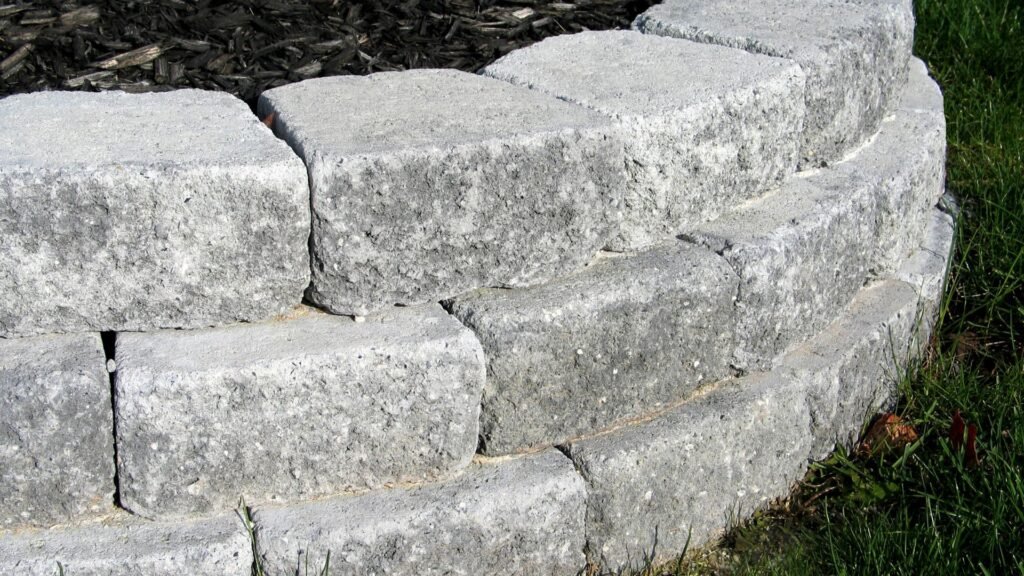
DIY Vs. Professional Installation: What’s Right For You?
When it comes to installing retaining walls, one of the first decisions you’ll face is whether to tackle the project yourself or hire a professional. Each option has its own benefits and challenges, and the best choice depends largely on the scope of the project, your experience level, and the materials involved. Let’s break down the considerations for both DIY and professional installation to help you make the right decision for your specific situation.
DIY Considerations
1. Smaller Projects Are Ideal for DIY
If you’re working on a relatively small retaining wall—such as one made from timber or smaller concrete blocks—this could be a manageable DIY project. These materials are easier to work with and typically don’t require heavy machinery, making them suitable for a homeowner with basic construction skills. These projects are often less than 4 feet in height, a manageable size for those looking to avoid major structural concerns.
2. Tools and Skills You’ll Need
A successful DIY retaining wall project requires not just the right materials, but also the correct tools and skills. The essential tools for a DIY retaining wall include:
- A shovel for digging the trench where the wall will sit.
- A level to ensure each row of blocks or timbers is perfectly horizontal.
- A hammer or mallet for setting materials into place.
- A tape measure to maintain consistent spacing and alignment.
Depending on the complexity of the project, you may also need a circular saw for cutting timber or other materials to size, as well as a wheelbarrow for transporting materials. Having a basic understanding of construction principles, such as maintaining level surfaces and managing load-bearing walls, will also be critical.
3. Common DIY Challenges
While smaller retaining wall projects can be great for DIY, there are some challenges you should be aware of. One of the biggest issues DIY builders face is improper drainage. Retaining walls must allow water to drain away from the wall to avoid pressure buildup behind the structure, which can lead to bulging or even collapse. Ensuring proper drainage often involves adding gravel and possibly installing a drainage pipe behind the wall.
Another challenge is ensuring the wall’s stability. Proper anchoring and support are key, especially if the wall is retaining a significant amount of soil. Even a slight mistake in leveling or alignment can result in a weakened wall that may need costly repairs down the line.
When to Hire a Professional
1. Large or Complicated Projects Call for Experts
For larger retaining wall projects, particularly those taller than 4 feet or on steep slopes, hiring a professional is usually the best choice. Tall walls need to be carefully engineered to ensure they can bear the load of the earth behind them. Sloped sites often require terracing or additional support systems that are beyond the scope of most DIYers. In these cases, professionals bring the experience and equipment necessary to complete the job safely and efficiently.
2. Complex Materials Require Expert Installation
If you’re considering more complex or expensive materials, such as natural stone or gabion walls, professional installation is recommended. These materials often require precise fitting and advanced knowledge of construction techniques. Stone walls, for example, involve detailed masonry work that can be time-consuming and difficult for someone without specialized training. Gabion walls, made from wire mesh filled with rocks, also require precision to ensure they are built correctly and maintain their strength over time.
3. Regulatory Considerations and Permits
For larger projects, you may also need to navigate local building codes and regulations, which can require permits or engineering plans. In these cases, hiring a professional ensures that your retaining wall meets all safety standards and legal requirements. Professionals will be familiar with local codes and can handle the paperwork and inspections needed to keep your project compliant. This is particularly important if the wall could affect nearby properties or structures, as improper construction could result in costly legal disputes.
Choosing between DIY and professional installation for your retaining wall project depends largely on the size, complexity, and materials of the job, as well as your skill level and comfort with handling potential challenges. Smaller, simpler projects can often be handled by DIY enthusiasts with the right tools and knowledge. However, for larger, more complex, or regulatory-heavy projects, hiring a professional ensures a safe, durable, and compliant retaining wall that stands the test of time. Carefully consider the scope of your project and don’t hesitate to call in an expert when the job requires it.

Maintenance Tips For Retaining Walls In NZ
Retaining walls are essential for many homes in New Zealand, especially for properties built on slopes or uneven terrain. To ensure the longevity and structural integrity of your retaining wall, it’s important to perform regular maintenance. Here are some key tips to help homeowners keep their retaining walls in excellent condition:
1. Regular Inspections
Frequent inspections are crucial for identifying potential issues early on. Homeowners should make a habit of walking along their retaining walls every few months, checking for signs of damage. Look for visible cracks, bulges, or any water buildup around the base or surface of the wall. These could indicate structural weaknesses or drainage problems, both of which need to be addressed promptly. Early detection can help prevent small issues from becoming costly repairs in the future.
2. Drainage Maintenance
One of the most common causes of retaining wall failure is poor drainage. In New Zealand’s often wet climate, ensuring proper water management around your wall is essential. Water should be able to flow freely away from the wall, and drainage systems such as weep holes, gravel backfill, and drainage pipes should be checked regularly. Blockages in these systems can lead to water pressure building up behind the wall, potentially causing cracks or shifting. Clean out any debris and ensure gravel and other materials are free of dirt that might obstruct drainage.
3. Timber Wall Care
Timber retaining walls are a popular choice due to their natural aesthetic and affordability. However, they require more care compared to other materials like concrete or stone. To extend the life of your timber retaining wall, it’s important to treat the wood with weatherproofing solutions designed to withstand New Zealand’s diverse climate. Applying a sealant or wood preservative will protect the timber from moisture, rot, and insect damage. Make sure to reapply these treatments as recommended by the manufacturer, especially after prolonged exposure to heavy rains or harsh sunlight.
4. Repair Tips
While some minor issues with retaining walls can be addressed with DIY repairs, it’s essential to know when professional help is necessary. Small cracks or areas where the mortar has chipped away can often be fixed with simple patching techniques. For timber walls, replacing damaged boards or applying extra sealant might be sufficient. However, if you notice significant problems such as leaning walls, large cracks, or persistent water pooling, it’s time to call in an expert. Major issues can compromise the stability of the wall and should not be ignored, as they could lead to more severe damage to your property.
Maintaining your retaining wall in New Zealand doesn’t have to be a daunting task. With regular inspections, proper drainage management, and timely repairs, you can ensure your wall remains in top shape for years to come.

Retaining Wall Costs In NZ
When planning a retaining wall project in New Zealand, understanding the cost involved is crucial to making informed decisions. The price of constructing a retaining wall depends on various factors, including material selection, labor, site conditions, and design complexity. In this section, we break down the key elements that influence retaining wall costs to help you budget effectively.
1. Material Breakdown
The choice of material is one of the most significant factors affecting the cost of a retaining wall. Different materials not only vary in price but also in durability, maintenance requirements, and aesthetic appeal. Here’s a rough estimate of costs based on the most common material types used in New Zealand:
- Timber Retaining Walls: Timber is one of the more affordable options, and it’s commonly used in residential properties. Prices for timber retaining walls typically range from $150 to $300 per square meter, depending on the type of wood and the quality of treatment applied to make it resistant to rot and termites.
- Concrete Block Retaining Walls: Concrete blocks are a durable and long-lasting option, often used in larger or more complex projects. However, they come with a higher price tag due to material costs and the additional labor required for construction. You can expect to pay between $300 to $500 per square meter for a concrete block retaining wall.
- Stone Retaining Walls: For a more natural and aesthetic look, stone retaining walls are a popular choice. These walls can be built using a variety of stone types, with prices varying accordingly. Stone retaining walls tend to be more expensive, with costs ranging from $400 to $700 per square meter, depending on the stone’s availability and the complexity of the installation process.
2. Factors That Affect Cost
In addition to the material, several other factors influence the final cost of a retaining wall. Understanding these factors will help you estimate a more accurate budget for your project:
- Height and Length of the Wall: Taller and longer walls require more materials and labor, which directly increases the cost. Additionally, walls over a certain height may require engineering input and council consent, adding to the overall expense.
- Wall Complexity: The more complex the design, the more expensive the project becomes. For example, curved walls or multi-tiered retaining walls involve more intricate construction techniques, which increases labor costs.
- Site Conditions and Accessibility: If your site has difficult terrain or limited access for construction equipment, it may take longer to build the retaining wall, which drives up labor costs. Additionally, areas with poor soil conditions may require extra foundation work to ensure the wall’s stability.
- Drainage and Reinforcement Requirements: Proper drainage is essential for retaining walls to prevent water buildup behind the wall, which can lead to failure. Depending on the site’s natural drainage, you may need to install additional drainage systems, which adds to the overall cost. Similarly, if your wall requires reinforcement (such as steel rods or geogrid systems), this will increase the material and installation costs.
3. DIY vs. Hiring a Professional
When considering the cost of a retaining wall, it’s important to weigh the pros and cons of building it yourself versus hiring a professional. Here’s a comparison of both options:
- DIY Build: Building a retaining wall yourself can save you a significant amount of money in labor costs. However, it’s important to remember that DIY projects often take longer to complete, and there is a risk of mistakes if you lack experience. The cost of materials remains the same, but you could save anywhere from 30% to 50% of the total cost by doing the work yourself. However, poorly constructed DIY retaining walls may have shorter lifespans and could require more maintenance down the line.
- Hiring a Professional: While hiring a professional contractor will increase the cost, it ensures the job is done correctly, with high-quality materials and expert craftsmanship. Professionals are more likely to build a wall that lasts longer and requires less maintenance. For example, a professional build might cost anywhere from $500 to $1,000 per square meter, depending on the complexity of the project. This initial investment often pays off in the long term due to the durability and lower upkeep of the professionally installed wall.
In conclusion, the cost of building a retaining wall in New Zealand can vary significantly depending on the materials, design, and whether you choose to DIY or hire a professional. By carefully considering these factors, you can make the best decision for your needs and budget, ensuring that your retaining wall is both functional and cost-effective in the long run.
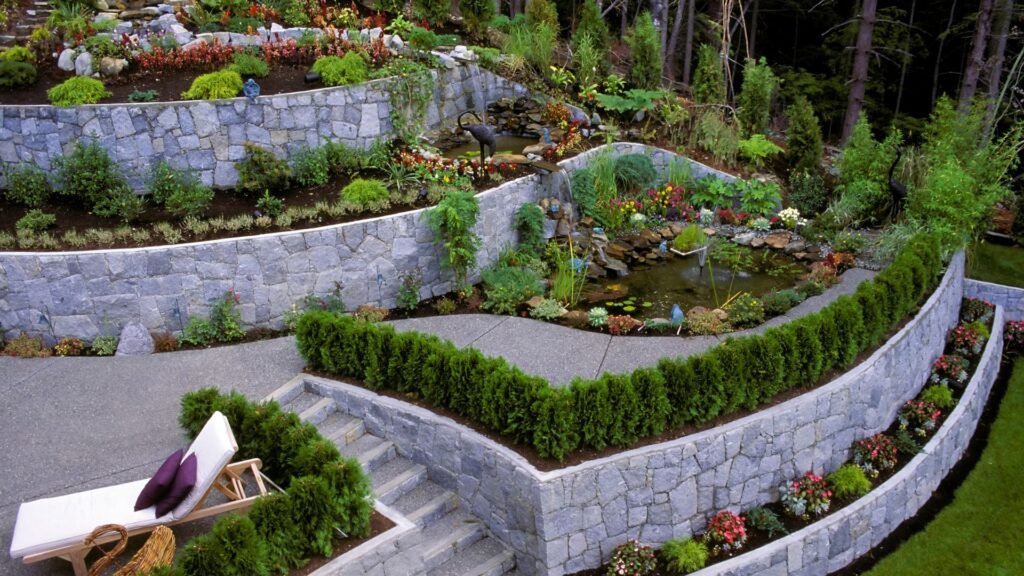
FAQs: About Retaining Walls NZ
What is a retaining wall, and why is it important in New Zealand?
A retaining wall is a structure built to hold back soil and prevent erosion, particularly in sloped areas. In New Zealand, where the terrain is often hilly, retaining walls are crucial for creating usable space, preventing soil erosion, and managing water flow, especially during heavy rainfalls.
What are the most common types of retaining walls in NZ?
The most common types of retaining walls in New Zealand include timber walls, concrete walls, stone walls, and gabion walls. Each material has its pros and cons depending on the project’s scale, budget, and aesthetic preferences.
How do I choose the right retaining wall material for my property?
To choose the right material, consider the purpose of the wall, your budget, and the aesthetic you want. Timber is affordable and easy for DIY, while concrete offers durability, and stone gives a natural, high-end look. Gabion walls are eco-friendly and modern but may require professional installation.
Can I build a retaining wall myself, or should I hire a professional?
Small retaining walls, especially timber or concrete block walls under 1.5 meters, can be suitable for DIY if you have the right tools and skills. However, larger or more complex walls, especially those made from stone or requiring permits, are best left to professionals.
Do I need a permit to build a retaining wall in New Zealand?
In most cases, retaining walls over 1.5 meters in height or walls that support significant loads will require a permit in New Zealand. It’s important to check with your local council for specific regulations and permit requirements before starting your project.
What are the benefits of installing a retaining wall?
Retaining walls prevent soil erosion, create flat usable spaces in sloped areas, enhance the visual appeal of outdoor spaces, and can increase property value. They are essential for managing water flow and creating stable landscaping in hilly environments.
How much does it cost to build a retaining wall in New Zealand?
The cost varies based on materials, size, and complexity. Timber walls can cost between $150 to $300 per square meter, while concrete walls range from $300 to $500 per square meter. Stone walls tend to be the most expensive due to the material and labor involved.
What kind of maintenance do retaining walls require?
Retaining walls require periodic inspections for cracks, bulging, or water buildup. Drainage systems should be checked regularly, and timber walls may need to be treated with weatherproofing solutions to extend their lifespan. Quick repairs for minor issues can prevent bigger, more costly problems down the road.
How long do retaining walls last?
The lifespan of a retaining wall depends on the material used and how well it’s maintained. Timber walls typically last 15-20 years with proper care, while concrete and stone walls can last 50 years or more. Gabion walls can last several decades if the wire cages are properly treated to prevent rust.
Can a retaining wall increase the value of my property?
Yes, a well-constructed and aesthetically pleasing retaining wall can increase your property’s value. By adding usable outdoor space, improving landscape aesthetics, and managing erosion, retaining walls often make properties more attractive to potential buyers.
Conclusion
In conclusion, when choosing the right retaining wall for your project, it’s important to consider the different types available, such as gravity walls, cantilevered walls, and anchored walls, each offering unique benefits depending on your specific needs. A well-designed retaining wall not only enhances the aesthetic appeal of your landscape but also provides essential structural support, especially for managing slopes or preventing erosion. Whether you’re planning a DIY installation or seeking professional help, taking the time to plan your project carefully is crucial for long-term success. Don’t hesitate to share your retaining wall ideas in the comments or reach out for expert advice to ensure you get the best results.
About the Author:
Mike Veail is a recognized digital marketing expert with over 6 years of experience in helping tradespeople and small businesses thrive online. A former quantity surveyor, Mike combines deep industry knowledge with hands-on expertise in SEO and Google Ads. His marketing strategies are tailored to the specific needs of the trades sector, helping businesses increase visibility and generate more leads through proven, ethical methods.
Mike has successfully partnered with numerous companies, establishing a track record of delivering measurable results. His work has been featured across various platforms that showcase his expertise in lead generation and online marketing for the trades sector.
Learn more about Mike's experience and services at https://theleadguy.online or follow him on social media:

